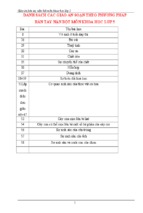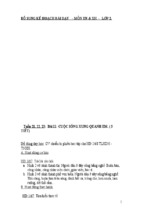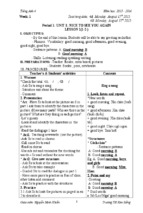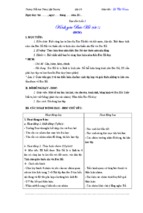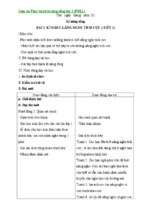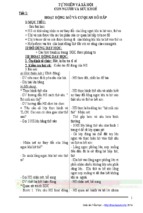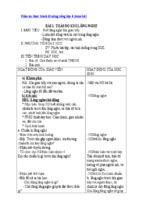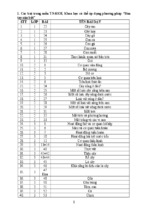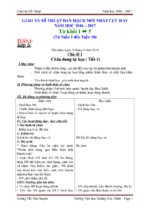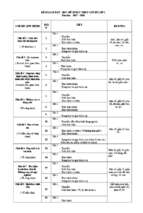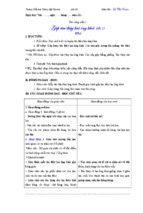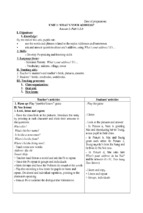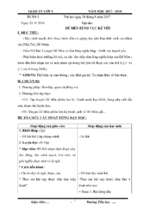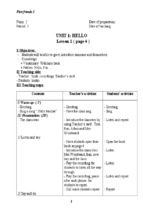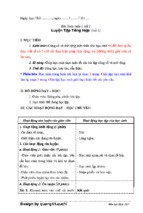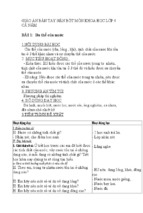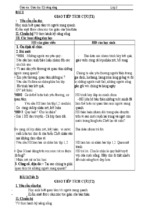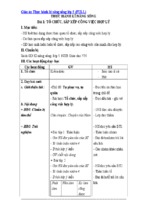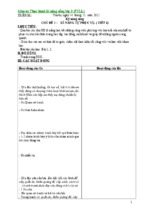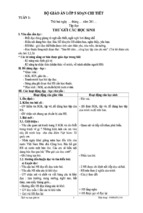Week: 19
Period: 52
Planning date:2/1/2016
Teaching date: 4/1/2016
Unit 11:WHAT TIME IS IT?
Lesson 1: 1 - 2
I. Objectives: After the lesson Ss will be able to: - Ask and answer questions about
the time. Listen for specific information. Develop listening, speaking skills.
- Ss look after , solve problems and study themselves.
- Studious and obedient students and love their friends.
II. Language focus:
- Vocabulary: have (breakfast, lunch, dinner), go home, go to bed,....
- Sentence patterns: - What time is it? - It’s seven o’clock
III. Teaching methods:
- Communicative approach.
- Techniques: Ask and answer (say individually);Work in pairs/ groups;Discuss..
IV. Resources: CD and radio, students’ book
V. Procedure:
Teacher’s work
Warm up
play the game: Table tennis
- Give the comment.
1. Look , listen and repeat
- Introduce the dialogue
- Play the CD for the ss.
- Represent the way to ask
questions about the time
and how to answer.
2. Look and say
- Give the meaning of new
words.
Students’ activities
- Play the game.
Say about numbers from one to sixty.
- Read aloud all numbers they have revised.
- Ss look at the picture and identify the characters
and what they are doing.
- Look and listen to the tape.
- Ss listen and repeat, focus on some words.
- Listen and repeat in pair.
- Listen and note down:
- What time is it? - It is six..
- Read and check.
- Ss look at the picture and identify the time in
each picture.
- Note down.
Seven
seven fifteen
seven thirty
seven twenty-five
seven forty-five
- Call some ss to read.
- Ss read aloud the new words in chorus.
- Check ss’understanding by - Read before the class.
a game: What and where
- Look & rewite the new words on the right places.
- Listen and pay attention.
- Do the task with a student. - What time is it? - It is seven o’clock.
- Ss practice speaking in pairs about time.
1
- Check and corect.
Reinforcement and
homelink:
- 4-5 pairs say in front of the class . The rest of the
class listen and give comments.
- Ss do A,B at home..
Week: 19
Period: 53
Planning date:2/1/2016
Teaching date: 4-5/1/2016
Unit 11:WHAT TIME IS IT?
Lesson : 1 - 2 - 3
I. Objectives: After the lesson, students are able to: Asking and answering these q
the questions about daily rountines. Develop listening, speaking skills.
- Ss look after , solve problems and study themselves.
- Studious and obedient students and love their friends.
II. Language focus:
- Vocabulary: Have(breakfast, lunch, dinner), get up, at....
- Sentence patterns: - What time do you go to school?
- I go to school at seven o’clock.
III. Teaching methods:
- Communicative approach.
- Techniques: Ask and answer (say individually);Work in pairs/ groups;Discuss..
IV. Resources: - CD and radio, student’s book , Workbook
V. Procedure
Teacher’s work
Students’ activities
Warm up:
- play the game: drawing - Work in groups to play the game. Ss draw a clock.
and say the time.
1. Look, listen and
S1: It is seven. S2: it is eight fifteen. S3: ..........
repeat.
- Introduce the dialogue - Ss look at the picture and identify the characters and
what they are doing.
- Explain new the phrase - Ss listen to the dialogue.
- Listen and repeat each line of the dialogue.
- The class read into two groups to play roles.
2. Point and say
- 4 Ss Read in pairs, the others listen & give comment
- Present some more new - Ss look at the picture and identify the characters and
words of activities after the activities of them.
revising some they have
learnt.
- Listen and repeat.
Get up
Go to school Go to bed
Have lunch
Have breafast Have dinner
Watch TV
- Check ss’
- Read all words in chorus.
2
understanding by slap
the board game.
- Do picture a as a
model.
T:What time do you ....?
3. Let’s talk
Asking Ss to talk
- What time is it?
- What time do you...?
- Correct.
Homelink:
- Read before the class.
- Play the game in 2 teams.
- Practice asking and answering the questions about
the time of daily rountines in pairs.
- Listen and repeat:
S: - I .... at .......
- Act it out and correct.
- Some pairs to say in front of the class.
- Pactice in pair.
- Some pairs to talk in front of the class. Others give
comments.
- Ss do Ex in Part E (WB).
Week: 19
Period: 54
Planning date:2/1/2016
Teaching date: 7-8/1/2016
Unit 11: MY DAILY ACTIVITIES
Lesson 3
I. Objectives: After the lesson, students are able to: - Pronounce correctly the
sound of the letters “oo”. Develop listening and writing skills.
- Ss look after , solve problems and study themselves.
- Studious and obedient students and love their friends.
II. Language focus: - Phonics: the letters “ oo”.
III. Teaching methods:
- Communicative approach.
- Techniques: Ask and answer (say individually);Work in pairs/ groups;Discuss..
IV. Resources: - CD and radio, student’s book , Workbook
V. Procedure:
Teacher’s work
Students’ activities
Play game in 3 groups.
Warm up
- Have ss play the Network
game.
Daily
get up
- Check.
rountines
1. Listen and repeat.
- Guiding Ss to produce the
sound of the letter “oo”.
- Check some ss.
go to school
- Read in chorus.
- Ss pay attention to the letters coloured differently
- Ss learn to produce the sound of the letters “ oo”.
- Ss repeat each line of the text in chorus.
- Ss read in groups/ in pairs.
3
2. Listen and write. Then
- Pupils look at the sentences, read and guess the
say aloud.
words to write.
- Guide Ss to listen & write. - Listen to the tape twice and write the words in
the blank. Compare the answer with the partner.
- Listen to the tape again & check their answers.
- Check and correct.
- Pupils give the key. The rest of the class write
in the notebooks.
- Ps listen to the tape and repeat the chant
3. Let’s chant (p10)
- Ps chant in group and individual.
- Introduce the Chant :
- Ps chant and do the action
What time do you go to
school?
- Check in pairs.
-Teacher reinforce their
pronunciation
- Ss do exercises in C, D (WB) at home.
Homelink:
Week: 20
Period: 55
Planning date:6/1/2016
Teaching date: 11/1/2016
Unit 11:WHAT TIME IS IT?
Lesson 1-2-3 : 4-5-5
I. Objectives: After the lesson, students are able to: Asking and answering these q
the questions about daily rountines. Develop listening, wrinting skills.
- Ss look after , solve problems and study themselves.
- Studious and obedient students and love their friends.
II. Language focus:
- Vocabulary: Have(breakfast, lunch, dinner), get up, at....
- Sentence patterns: - What time do you go to school?
- I go to school at seven o’clock.
III. Teaching methods:
- Communicative approach.
- Techniques: Ask and answer (say individually);Work in pairs/ groups;Discuss..
IV. Resources: - CD and radio, student’s book , Workbook
V. Procedure
Teacher’s work
Students’ activities
Warm up: - Play recording
the song: What time is it?
- Listen and sing.
4. Listen and tick
- Guiding Ss to look the
- Ss look at the picture in part 3 (p. 7) & identify
pictures, listen and tick.
the time of each the clock. Then guess
- Listen to the tape twice & tick. Check their guess
- 4-5 Ss. The rest of the class compare the answer
- Call some Ss to report the
with the partner.
key.
- Listen once again and check the answer. Retell
- Check and correct.
4
what they have heard.
5. Look and write
- Guide ss to complete the
exercise.
- Call on some Ss to report
the answers .
- Check and correct.
- Look at the sentences, the pictures, draw the time
and write about themselves.
- Complete the excercise in individual.
- 4 Ss write the sentences they have written. 6-7 Ss
read aloud. The rest of the class give comments.
5. Let’s write.
- Guide ss to complete the
exercise.
- Call on some Ss to report
the answers .
- Check and correct.
Reinforcement and
homelink:
- Look at the sentences and the pictures (p11) to
find the suitable words to fill.
- Complete the excercise in individually.
- Check and compare the answer with the partner.
- 6-7 Ss read aloud the answers. The rest of the
class listen and give comments
- Ss do part E(workbook) at home.
Week: 20
Period: 56
Planning date:6/1/2016
Teaching date: 11-12/1/2016
Unit 12: WHAT DOES YOUR FATHER DO?
Lesson 1: 1.2
I. Objectives: After the lesson Ss will be able to: Ask and answer questions about
someone’s jobs. Develop listening and speaking skills.
- Ss look after , solve problems and study themselves.
- Studious and obedient students and love their friends.
II. Language focus:
- Vocabulary: worker,doctor, driver, farmer, bisineseman, housewife.
- Sentence patterns: - What does your father/ mother do? - He/She’s a doctor.
III. Teaching methods:
- Communicative approach.
- Techniques: Ask and answer (say individually);Work in pairs/ groups;Discuss.
IV. Resources: CD and radio, students’ book
V. Procedure:
Teacher’s work
Warm up
* Have Ss play the game:
Slap the board.
Students’ activities
- Work in groups to play the game.
sister
mother
father
5
grandmoth
er
grandthe
r
- Give the comment.
1. Look , listen and repeat
- Introduce the dialogue Play the CD for the ss.
- Present the way to ask
questions about the jobs.
- Check some groups.
2. Point and say
- Teaches and give the
meaning of new words.
- Check ss’understanding by
a game: What and where
- Do the task with a student
and then
- Check ss.
Reinforcement and
homelink:
Week: 20
Period: 57
brother
- Read aloud all words they have revised.
- Ss look at the picture and identify the
characters and what they are doing.
- Look and listen to Nam and Mai who are
talking about jobs of Mai’s family members.
- Listen and repeat.
- Ss read the dialogue in pair.
- Listen and note down:
- What’s his/her job?- He/She’s a doctor.
- Ss look at the picture and identify the jobs in
each picture.
- Note down.
nurse
driver
farmer
factory worker
uncle
- Read the new words in chorus, individual.
- Look and rewite the new words on the right
places.
- Practice speaking.
T: What’s her job? S: She’s a doctor.
- Act it out and correct.
- Do part A.B( workbook) at home.
Planning date:6/1/2016
Teaching date: 14-15/1/2016
Unit 12: WHAT DOES YOUR FATHER DO?
Lesson 2: 1-2-3
I. Objectives: After the lesson, students are able to:
- Asking, answering the questions about the places to work. Develop speaking skill
- Ss look after , solve problems and study themselves.
- Studious and obedient students and love their friends.
II. Language focus:
- Vocabulary: work, a hospital, a factory, a field, an office
- Sentence patterns: - Where does a ...... work?- A.... works .......
III. Teaching methods:
6
- Communicative approach.
- Techniques: Ask and answer (say individually);Work in pairs/ groups;Discuss.
IV. Resources:
- CD and radio, student’s book , Workbook
V. Procedure
Teacher’s work
Students’ activities
Warm up:
- Have ss play the Guessing Play the game.
What does your ......do? He/ She is ......
game.
Whole class ask: What does your.....do?
Others to look and guess about her/his jobs.
1. Listen and repeat.
- Ss look at the picture and identify the characters
- Introduce the dialogue.
and what they are doing.
- Play the CD for the ss to
- Look and listen to Nam and Mai who are talking
listen.
about jobs of Mai’s family members.
- Listen and repeat.
- Present the way to ask
- Ss read the dialogue in pair.
questions about about the
- Listen and note down:
places to work.
- Where does a....... work? - A...... works in ......
- Read in groups to play roles.
- Read in pairs, the others listen and give
- Call some pairs to read
comment.
aloud.
2. Point and say
- Ss look at the picture and identify the location in
- Present some more new
each picture.
words of the location.
- Listen and repeat all new words.
- Check ss’ understanding
A hospital
A factory
A field
an office
by slap the board game.
- Ss practice asking and answering the question
Where does a..... work?”- A......works in.....
- Do picture a as a model.
- Ss work in pairs to practice.
- Act it out and correct.
- 6-7 pairs talk in front of the class. Others give
- Check and correct.
comments.
3. Let’s talk
- Practice in pair, group.
- Guiding Ss to talk free
- 7-8 pair display. Others give comments.
about their famimly
members.
Reinforcement and
- Ss do Ex in Part C (WB).
homelink:
Week: 21
Period: 58
Planning date:15/1/2016
Teaching date: 18/1/2016
7
Unit 12: WHAT DOES YOUR FATHER DO?
Lesson 3: 1-2-3
I. Objectives: After the lesson, students are able to:
- Pronounce correctly the sound of the letters “ ie” and “ea”. Develop listening,
reading skills.
- Ss look after , solve problems and study themselves.
- Studious and obedient students and love their friends.
II. Language focus:
- Phonics: the letters “ ie” and “ea”
III. Teaching methods:
- Communicative approach.
- Techniques: Ask and answer (say individually);Work in pairs/ groups;Discuss.
IV. Resources:
- CD and radio, student’s book , Workbook
V. Procedure
Teacher’s work
Students’ activities
Warm up
- Work in groups to play the game. Talk about
- Have Ss play the game:
their family members’s jobs.
chatting
1. Listen and repeat.
- Guiding Ss to produce the - Ss look at part 1 and pay attention to the letters
sound of the letters “ ie” and coloured differently.
- Ss learn to produce the sound of the letters “ ie”
“ea” .
and “ea” .
- Play the CD
- Listen and note.
- Ss listen & repeat each line of the text in chorus.
- Ss read in groups/ in pairs.
- Give out and check.
- Check some ss.
2. Listen & circle. Then say
sentences with the circled
- Look at the sentences, read and guess the words
- Guide Ss read sentences.
to circle.
- Listen twice and circle.
- Play the tape.
- Check their guess. Compare the answer with the
partner.
- 4 Ss give the key. The rest of the class listen and
- Check and correct.
- Call some Ss to give it out give comments.
- Give out and check.
on the board.
3. Let’s chant
- Introduce the Chant: Jobs
- Ps listen to the tape and chant
and places of work
- Ps chant in group & individual.
- Play the tape.
- Ps chant and do the action
-Teacher reinforce their
8
pronunciation.
Reinforcement and
homelink:
- Check in pairs.
- Ss do exercises in D (WB) at home.
Week: 21
Period: 59
Planning date:15/1/2016
Teaching date: 18-19/1/2016
Unit 12: WHAT DOES YOUR FATHER DO?
Lesson 2-3: 4-5-5
I. Objectives: revision about: - Asking, answering the questions about someone’s
jobs, the places to work. Develop listening and writing skill
- Ss look after , solve problems and study themselves.
- Studious and obedient students and love their friends.
II. Language focus:
- Vocabulary: work, a hospital, a factory, a field, an office
- Sentence patterns: - Where does a ...... work?- A.... works .......
III. Teaching methods:
- Communicative approach.
- Techniques: Ask and answer (say individually);Work in pairs/ groups;Discuss.
IV. Resources:
- CD and radio, student’s book , Workbook
V. Procedure
Teacher’s activities
Students’ activities
Warm up: - Say greetings.
- Respond.
4. Listen and number.
-Guide Ss to look the pictures - Ss look at the pictures in part 4(p15). Identify
charactersand their jobs in each picture, guess.
- Listen twice and number the pictures. Check
- Call some Ss to respond the their guess. Compare the answer with the partner
answer .
- 4 Ss answer. Other give comment.
- Correct.
- Listen again and check. Ss retell what they have
Key: 1. b 2. a 3.c 4.d
listened.
- Look at the sentences and the pictures (p15) to
5. Look and write
find the suitable words to fill.
- Guide ss to complete the
- Complete the excercise in individually.
exercise.
- 2 Ss write on the board, 6-7 Ss read aloud the
- Call on some Ss to report
sentences they have written.The rest of the class
the answers .
listen & give comments
- Check and correct.
5. Write about the jobs of
your familymembers and
- Pupils look at the book on the P17. Read the
where they work.
- Guide Ss how to write their sentences and find suitable words to write in
individual.
family( jobs of family
9
members).
- Check and correct
Reinforcement and
homelink:
- Ask Ss to do exercise at
home.
Week: 21
Period: 60
- Ss trade their answers in pairs for correction
- 3 Ss write on the board. The others listen and
give comments.
- Do exercises in E (WB) at home.
Planning date:15/1/2016
Teaching date: 21-22/1/2016
Unit 13: WOULD YOU LIKE SOME MILK?
Lesson 1: 1.2
I. Objectives: After the lesson Ss will be able to: Asking and answering questions
about favourite food and drink. Develop listening and speaking skills.
- Ss look after , solve problems and study themselves.
- Studious and obedient students and love their friends.
II. Language focus:
- Vocabulary: words about food and drink
- Sentence patterns: - What’s your favourite food/ drink? - It’s.....
III. Teaching methods:
- Communicative approach.
- Techniques: Ask and answer (say individually);Work in pairs/ groups;Discuss.
IV. Resources:
- CD and radio, student’s book , Workbook
V. Procedure
Teacher’s work
Students’ activities
Warm up
- Work in groups to play the game.
* Have Ss play the game:
+ What colour is it?
Guessing game.
+ Is it big ?
- Prepare a packet of milk and put + Is it small?
it in to a box.
+ Is it used to drink?
- Ask ss to ask some questions, T + Is it used to eat?
answers, ss listen and find out
what it is.
1. Look , listen and repeat
- Ss look at the picture and identify the
- Introduce the dialogue:
characters and what they are doing.
- Play the CD for the ss.
- Look and listen to Tom and Mai talking
about their favourite food and drink..
- Present the way to ask questions - Listen and repeat.
about favourite food and drink.
- Listen and note down:
- What’s your favorite food/ drink?- It’s....
10
- Check some groups.
2. Point and say
- Teach and give the meaning of
new words.
- Check ss’understanding by a
game: What and where.
- Represent the way to ask and
answer questions about favourtite
food, drink.
- Model with a student.
- Check ss.
Reinforcement and homelink:
- Ask Ss to do A,B at home.
Week: 22
Period: 61
- Ss read the dialogue in pair.
- Ss look at the picture and identify the food
and drink in each picture.
- Note down.
beef
pork
orange juice
milk
water
chicken
- Read aloud the new words in chorus.
- Some Ss read before the class.
- Look and rewite the new words on the
right places.
- Listen and pay attention.
- What’s your favorite food/ drink?- It’s....
- Practice speaking in pair.
- Act it out and correct.
- Do at home.
Planning date:21/1/2016
Teaching date: 25/1/2016
Unit 13: WOULD YOU LIKE SOME MILK?
Lesson 2: 1.2.3
I. Objectives: After the lesson, students are able to: - Offering someone food or
drink and accepting or declining someone’s offer. Develop: Speasking skill.
- Ss look after , solve problems and study themselves.
- Studious and obedient students and love their friends.
II. Language focus:
- Vocabulary: noodles,bread, rice, lemonade, coffee, tea..
- Sentence patterns: - Would you like some bread? - Yes, please/ No, thanks.
III. Teaching methods:
- Communicative approach.
- Techniques: Ask and answer (say individually);Work in pairs/ groups;Discuss.
IV. Resources:
- CD and radio, student’s book , Workbook
V. Procedure
Teacher’s work
Students’ activities
Warm up:
- Have ss play the slap the
- Work in groups to play the game.
board game.
pork
drin
k
food
chicken
water
milk
beef
11
1. Look, listen and repeat.
- Introduce the dialogue
- Play the CD for the ss.
- Present the way to offer
someone food and drink.
Explain new the grammar.
- Check some groups.
2. Point and say
- Present some more new
words of food and drink.
- Check ss’ understanding by
slap the board game.
- Do picture a as a model.
- Check and correct.
3. Let’s talk
- Guiding Ss to talk.
- Call some pairs to talk.
- Check and correct.
Reinforcement and homelink
- Ss look at the picture(p20) and identify the
characters and what they are doing.
- Look and listen to Mai’mother offering Linda
food and drink.
- Listen and repeat each line of the dialogue.
- Listen and note down:
-Would you like some...?Yes, please/ No, thanks
- Read in groups to play roles.
- Read in pairs( 4-5pairs), the others listen and
give comment.
- Ss look at the picture and identify food and
drink in each picture.
- Listen and repeat all words.
Bread noodles
rice
lemonade
coffee
tea
vegetables
- 5-6 Ss read before the class.
- Play the game in 2 teams.
- Practice in pairs
- Listen and repeat:
T: Would you like some bread?
S - Yes, please/ No, thanks.
- Act it out and correct.
- Talking in pair
1. What your favourite food/drink?
2. Would you like some...?
- 7-8 pairs talk in front of the class. Other give
comments.
Ss do Ex in Part C (WB).
Week: 22
Period: 62
Planning date:21/1/2016
Teaching date: 25-26/1/2016
Unit 13: WOULD YOU LIKE SOME MILK?
Lesson 3: 1.2.3
I. Objectives: After the lesson, students are able to: Pronounce correctly the
sound of the letters “ sh ” and “f”. Develop: Listening and writing skills.
- Ss look after , solve problems and study themselves.
- Studious and obedient students and love their friends.
12
II. Language focus:
- Phonics: the letters “ sh ” and “lk”.
III. Teaching methods:
- Communicative approach.
- Techniques: Ask and answer (say individually);Work in pairs/ groups;Discuss.
IV. Resources: CD and radio, students’ book
V. Procedure:
Teacher’s work
Students’ activities
Warm up
- Work in groups to play the game.
- Have Ss play the game: Slap
pork
the board.
beef
water
chicke
n
milk
fish
1. Listen and repeat.
- Guide Ss how to produce the
sound of the letters “ sh” and
“f” .
- Play the CD and ask Ss to
listen.
- Check some ss.
2. Listen and tick. Then write
and say aloud.
- Guide Ss to listen and tick.
- Play the CD
- Check and correct.
3. Let’s chant (p22)
- Introduce the Chant : Would
you like some fish?
-Teacher reinforce their
pronunciation
Reinforcement - homelink:
- Ss read all words
revised.
Apple
juice
- Ss look and pay attention to the letters
coloured differently.
- Ss learn to produce the sound of the letters “
sh” and “f” .
- Listen and repeat each line of the text in
chorus.
- Read in groups./ in pairs.
- Give out and check.
- Ss look at the sentences, read and guess the
words to tick .
- Listen to the tape 2 times & tick. Check their
guess. Compare the answer with the partner.
- Ss give the key: 4 Ss.
-The rest of the class write in the notebooks
- Ss retell what they have heard.
- Give out and check.
- Ps listen to the tape and chant
- Ps chant in group & individual.
- Ps chant and do the action
- Check in pairs
- Give out and check, the others clap their
hands.
- Ss do exercises in D (WB) at home.
13
Week: 22
Period: 63
Planning date:21/1/2016
Teaching date: 28-29/1/2016
Unit 13: WOULD YOU LIKE SOME MILK?
Lesson 2-3: 4.5.5
I. Objectives: Review: - Asking and answering about favourite food and drink.
Offering someone food or drink and accepting or declining someone’s offer.
Develop: Listening and writing skills.
- Ss look after , solve problems and study themselves.
- Studious and obedient students and love their friends.
II. Language focus:
- Vocabulary: noodles,bread, rice, lemonade, coffee, tea..
- Sentence patterns: - Would you like some bread? - Yes, please/ No, thanks.
III. Teaching methods:
- Communicative approach.
- Techniques: Ask and answer (say individually);Work in pairs/ groups;Discuss.
IV. Resources:
- CD and radio, student’s book , Workbook
V. Procedure
Teacher’s activities
Students’ activities
Warm up: - Say greetings.
- Respond.
4. Listen and number.
-Guide Ss to look the pictures - Ss look at the pictures in part 4(p21). Identify
food and drink in each picture, guess.
- Listen twice and number the pictures. Check
- Call some Ss to respond the their guess. Compare the answer with the partner
answer .
- 4 Ss answer. Other give comment.
- Correct.
- Listen again and check. Ss retell what they have
Key: 1. c 2. a 3.b 4.d
listened.
- Look at the pictures (p21) to find the suitable
5. Look and write
words to fill.
- Guide ss to complete the
- Complete the excercise in individually.
exercise.
- 2 Ss write on the board, 6-7 Ss read aloud the
- Call on some Ss to report
sentences they have written.The rest of the class
the answers .
listen & give comments
- Check and correct.
5. Write about your favourite
food and drink.
- Guide Ss how to write their - Pupils look at the book on the P23. Read the
sentences and write about their favourite food
favourite food and drink.
and drink. Work in individual.
- Ss trade their answers in pairs for correction
- Check and correct
- 3 Ss write on the board. The others give
Reinforcement and
comments.
homelink:
- Ask Ss to do exercise at
14
home.
- Do exercises in E (WB) at home.
Week: 23
Period: 64
Planning date:27/1/2016
Teaching date: 1/2/2016
Unit 14: WHAT DOES HE LOOK LIKE?
Lesson 1: 1.2
I. Objectives: After the lesson Ss will be able to: Ask and answer questions about
someone’s physical appearance. Develop: Speaking and listening skills.
- Ss look after , solve problems and study themselves.
- Studious and obedient students and love their friends.
II. Language focus:
- Vocabulary: words about someone’s physical appearance.
- Sentence patterns: - What does he/she look like? - He is/She is ....
III. Teaching methods:
- Communicative approach.
- Techniques: Ask and answer (say individually);Work in pairs/ groups;Discuss.
IV. Resources: CD and radio, students’ book
V. Procedure:
Teacher’s work
Warm up
* Have Ss play the game:
Chatting game.
S1: Who is this?
S1: What is her job?
S1: What is her favourite food?
S1: What is her favourite
drink?
- Give the comment.
1. Look , listen and repeat
- Introduce the dialogue:
- Play the CD for the ss.
- Present the way to ask
questions about someone’s
physical appearance.
- Check some groups.
Students’ activities
- Work in groups to play the game.
S2: This is my mother.
S2: She is a farmer.
S2: Fish.
S2: Milk.
- Identify the characters & what they are doing.
- Look and listen to Phong and Linda are
talking about a footballer.
- Listen and repeat each line of the dialogue.
- Listen and note down:
- What does he/she look like? - He is/She is ....
- Read in groups to play roles.
- Read in pairs( 4-5pairs), the others listen and
15
2. Point and say
- Give the meaning of new
words.
- Check ss’understanding by a
game: What and where.
- Do the model task with a
student.
- Check ss.
Reinforcement and
homelink:
- Ask Ss to do A,B at home.
give comment.
- Read and check.
- Ss look at the picture and identify the personal
physical appearance in each picture.
- Note down.
Tall short
slim old
young
- Read in chorus.
- Read aloud the new words before the class.
- Look and rewite the new words on the right
places.
- What does he/she look like? - He is/She is ....
- Practice speaking in pairs ask and answer
about personal physical appearance.
- Act it out and correct.
- Do at home.
Week: 23
Period: 65
Planning date:7/2/2016
Teaching date: 1-2/2/2016
Unit 14: WHAT DOES HE LOOK LIKE?
Lesson 2: 1.2.3
I. Objectives: After the lesson, students are able to: making comparison
someone’s physical appearance. Develop: Speaking skill.
- Ss look after , solve problems and study themselves.
- Studious and obedient students and love their friends.
II. Language focus:
- Vocabulary: tall-taller, short-shorter, big-bigger, old-older, young-younger.
- Sentence patterns: - Who’s ....? - ..... is......
III. Teaching methods:
- Communicative approach.
- Techniques: Ask and answer (say individually);Work in pairs/ groups;Discuss.
IV. Resources: CD and radio, students’ book
V. Procedure:
Teacher’s work
Warm up:
- Have ss play the slap the
board game.
1. Look , listen and repeat
- Introduce the dialogue:
- Play the CD for the ss.
Students’ activities
- Work in groups to play the game.
Tall short
slim old
young
- Identify the characters & compare someone’s
physical appearance .
16
- Present the way to ask
questions and answer about
making comparison
someone’s physical
appearance.
- Check some groups.
2. Point and say
- Give the meaning of new
words.
- Check ss’understanding by
a game: What and where.
- Do the model task with a
student.
- Check ss.
3. Let’s talk
- Guiding Ss to talk.
- Look and listen to Peter and Nam are talking
about their father and brother.
- Listen and repeat each line of the dialogue.
- Listen and note down:
- Who’s....? - ... is....
- Read in groups to play roles.
- Read in pairs( 4-5pairs), the others listen and
give comment.
- Read and check.
- Ss look at the picture and identify the personal
physical appearance in each picture.
- Note down.
Taller shorter
bigger older younger
- Read in chorus.
- Read aloud the new words before the class.
- Look and rewite the new words on the right
places.
- Practice speaking in pairs ask and answer about
personal physical appearance.
- Act it out and correct.
- Talking in pair
1. What does he/she look like?
2. Who’s taller/shorter/older...?
- 7-8 pairs talk in front of the class. Other give
- Call some pairs to talk.
comments.
- Check and correct.
Reinforcement & homelink: Ss do Ex in Part C (WB).
Week: 23
Period: 66
Planning date:7/2/2016
Teaching date: 4-5/2/2016
Unit 14: WHAT DOES HE LOOK LIKE?
Lesson 3: 1.2.3
I. Objectives: After the lesson, students are able to: Pronounce correctly the
sound of the letters “ th ”. Develop: Listening and speaking skills.
- Ss look after , solve problems and study themselves.
- Studious and obedient students and love their friends.
II. Language focus:
- Phonics: the letters “ th ”.
III. Teaching methods:
- Communicative approach.
- Techniques: Ask and answer (say individually);Work in pairs/ groups;Discuss.
17
IV. Resources: CD and radio, students’ book
V. Procedure:
Teacher’s work
Students’ activities
Warm up
- Have Ss play the game: Slap - Work in groups to play the game.
the board.
tall
slim
young
1. Listen and repeat.
- Guide Ss how to produce
the sound of the letters “ th”.
- Play the CD and ask Ss to
listen.
- Check some ss.
2. Listen and tick. Then write
and say aloud.
- Guide Ss to listen and tick.
- Play the CD
taller
shorter
younger
short
- Ss look and pay attention to the letters
coloured differently.
- Ss learn to produce the sound of the letters “
sh” and “f” .
- Listen and repeat each line of the text in chorus.
- Read in groups./ in pairs.
- Give out and check.
- Ss look at the sentences, read and guess the
words to tick .
- Listen to the tape 2 times & tick. Check their
guess. Compare the answer with the partner.
- Ss give the key: 4 Ss.
-The rest of the class write in the notebooks
- Check and correct.
- Ss retell what they have heard.
3. Let’s chant (p28)
- Give out and check.
- Introduce the Chant : This is - Ps listen to the tape and chant
my family.
- Ps chant in group & individual.
- Ps chant and do the action
-Teacher reinforce their
- Check in pairs
pronunciation
- Give out and check, the others clap their hands.
Reinforcement - homelink:
- Ss do exercises in D (WB) at home.
Week: 24
Period: 67
Planning date:11/2/2016
Teaching date: 15/2/2016
18
Unit 14: WHAT DOES HE LOOK LIKE?
Lesson 1.2.3: P3.5.5
I. Objectives: Review: Asking, answering and making comparison someone’s
physical appearance. Develop: listening and writing skills.
- Ss look after , solve problems and study themselves.
- Studious and obedient students and love their friends.
II. Language focus:
- Vocabulary: tall-taller, short-shorter, big-bigger, old-older, young-younger....
- Sentence patterns: - Who’s ....? - ..... is......
III. Teaching methods:
- Communicative approach.
- Techniques: Ask and answer (say individually);Work in pairs/ groups;Discuss.
IV. Resources: CD and radio, students’ book
V. Procedure:
Teacher’s activities
Students’ activities
Warm up: - Say greetings.
- Respond.
4. Listen and tick.
-Guide Ss to look the pictures - Ss look at the pictures in part 4(p25). Identify
someone’s physical appearance in each picture,
guess.
- Call some Ss to respond the - Listen twice and tick the pictures. Check their
answer .
guess. Compare the answer with the partner
- Correct.
- 4 Ss answer. Other give comment.
Key: 1. d 2. a 3.b 4.c
- Listen again and check. Ss retell what they have
5. Look and write
heard.
- Look at the pictures (p27) to find the suitable
- Guide ss to complete the
words to fill.
exercise.
- Complete the excercise in individually.
- Call on some Ss to report
- 2 Ss write on the board, 6-7 Ss read aloud the
the answers .
sentences they have written.The rest of the class
- Check and correct.
listen & give comments
5. Write.
- Guide Ss how to write their - Pupils look at the book on the P29. Read the
sentences and write about their family. Work in
family.
individual.
- Ss trade their answers in pairs for correction
- Check and correct
- 3 Ss write on the board. The others give
comments.
Reinforcement - homelink: - Do exercises in E (WB) at home.
Week: 24
Planning date:11/2/2016
Period: 68
Teaching date: 15-16/2/2016
Unit 15: WHEN’S CHILDREN DAY?
Lesson 1: 1.2
19
I. Objectives: After the lesson Ss will be able to: - Asking and answering
questions about when a festival is. Develop: Listening and speaking skills.
- Ss look after , solve problems and study themselves.
- Studious and obedient students and love their friends.
II. Language focus:
- Vocabulary: Tet, Mid-Autumn festival, Christmas, childrent’s Day, New year .
- Sentence patterns: - When is...? - It is on......
III. Teaching methods:
- Communicative approach.
- Techniques: Ask and answer (say individually);Work in pairs/ groups;Discuss.
IV. Resources: CD and radio, students’ book
V. Procedure:
Teacher’s work
Warm up
* Have Ss play the game:
Guessing game.
- Prepare a Chung cake and
put it in to a box.
1. Look , listen and repeat
- Introduce the dialogue
- Play the CD for the ss.
- Check some groups.
- Present the way to ask
questions and answer about
popular festivals.
2. Point and say
- Teach and give the meaning
of new words.
- Check ss’understanding by
a game: What and where.
- Do the model task with a
student.
- Check ss.
Reinforcement - homelink:
Students’ activities
- Work in groups to play the game.
- Ss look at the picture and identify the
characters and what they are doing.
- Look and listen to Mai & Tom talking about a
party for children’s Day.
- Listen and repeat each line of the dialogue.
- Read in groups to play roles.
- Read in pairs( 4-5pairs), the others listen and
give comment.
- Listen and note down:
- When is ...? - It is on ..... .
- Ss look at the picture and identify popular
festivals in each picture.
- Note down.
Tet, Christmas, childrent’s Day, New year...
- Read in chorus.
- Read aloud the new words before the class.
- Look and rewite the new words on the right
places.
- Practice speaking in pairs ask and answer about
personal physical appearance.
- Act it out and correct.
20
- Xem thêm -

